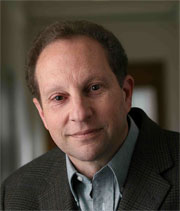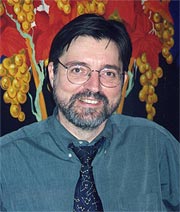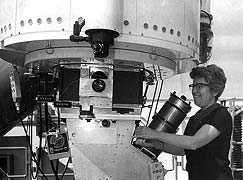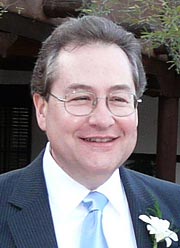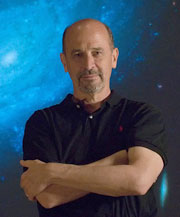Speakers
Public Lecture: “The Living History of the Universe”
7:30 p.m. March 17, 2010
Tucson Marriott University Park
Dr. Alan Dressler
Talk Abstract: Every minute of every day light from the remote past arrives at Earth, much of it originating before the Earth itself was born. Astronomers are uniquely privileged to have a look at history as it actually happened, but in practice gathering enough light from distant galaxies to learn something about them is not at all easy. Drawing connections from what we see in a younger universe to the one of our own time is also very challenging. A small history of this endeavor teaches us something about how science works and the persistence of human curiosity.
About the Speaker
Alan Dressler is an astronomer at the Observatories of the Carnegie Institution. His research has focused on galaxy evolution, particularly the issue of what leads to the diversity of different galaxy types and properties, including such affects as galaxy environment and interactions. Dressler has used large ground-based telescopes such as Magellan, and space telescope such as Hubble and Spitzer to look back in time to study the formation and evolution of galaxies, in particular, to better understand how much of what we see in today’s galaxies comes from “nature” versus “nurture.” Dressler’s HST & Beyond Committee proposed what is now called the James Webb Space Telescope, a successor to the Hubble planned for launch in 2014, and the OIR Panel of the 2000 Decadal Survey of Astronomy & Astrophysics that he chaired recommended private/public partnerships on giant new ground-based facilities LSST and GSMT, as well as greater access to all US telescopes through the NSF TSIP program. He is now chairing the Electromagnetic Observations from Space Panel of the present Decadal Survey that will recommend a program of new space telescopes beginning in this decade.
Talk Title: Star Formation in the Galaxy, an Observational Perspective
10:30 a.m. March 17, 2010
Tucson Marriott University Park
Dr. Charles Lada
Description: Dr. Lada will discuss the development of our understanding of star formation as a continuing process in the Milky Way. He will review the fundamental boundary and initial conditions relevant to the construction of a predictive theory of star formation that will be able to address such fundamental questions as how stars get their masses, and what determines the rate of star formation in molecular clouds.
About the Speaker
TBP
Talk Title: Galaxy Formation and Evolution: from the Outside
3:30 p.m. March 17, 2010
Tucson Marriott University Park
Dr. Heather Morrison
Description: Dr. Mossison’s talk will cover what we learn about galaxy formation both from the outer regions of stellar halos and from outer disks; both give insight to how galaxies group hierarchically, over different mass ranges.
About the Speaker
Heather Morrison is an astronomer who works to understand how galaxies form and evolve. She is an observer with strong connections to theory. She did her graduate work in Australia, and after postdoctoral positions as a Carnegie Fellow in Pasadena and a Hubble Fellow at NOAO, is now Professor of Astronomy at Case Western Reserve University. She has published extensively on the structure and origins of the Milky Way and Andromeda galaxies, and now chairs the SDSS’s SEGUE Survey’s Science team. She is keenly interested in philosophy of science, and co-founded the CWRU Women in Science and Engineering Roundtable in 2000.
Talk Title: Early Kitt Peak, Bright Galaxies, and Dark Matter
9:00 a.m. March 17, 2010
Tucson Marriott University Park
Dr. Vera Rubin
Description: We live in a Universe that is incredibly large and surprisingly complex. One of its many remarkable features is that we can understand some parts of it. I will describe my early observations at Kitt Peak and Lowell Observatories which led to the conclusions that most of the matter in the Universe is dark, not radiating at any wavelength. This may ultimately teach us fundamental new features about our Universe.
About the Speaker
Vera Rubin was born in Pennsylvania and raised in Washington, D.C. She earned her B.A. at Vassar College and her M.A. at Cornell University, where she made one of the first studies of deviations from the Hubble flow in the motions of galaxies. This work turned out to be the precursor of studies of the local supercluster. After earning her Ph.D. at Georgetown University under George Gamow, she taught at Montgomery County Junior College and at Georgetown. Since 1965 she has been at the Department of Terrestrial Magnetism of the Carnegie Institution of Washington. There she joined with W. Kent Ford, Jr., inventor of an image tube spectrograph, to measure rotation curves of spiral galaxies (and later, ellipticals as well). This work, which she has extended considerably as CCDs have replaced image tubes, led to the surprising discovery that most of the mass in galaxies is dark and that it resides in the outer parts, or haloes. She has been a leader in the study of the structure of galaxies, their internal motions, and large-scale motions in the Universe. Stating that she was inspired by the example of Maria Mitchell, Rubin has herself been an inspiration and mentor to many younger astronomers. She is at least as proud of her four children, all of whom have Ph.D.’s in math or science, as of her scientific achievements.
Talk Title: The New Solar Corona
9:00 a.m. March 17, 2010
Tucson Marriott University Park
Dr. Douglas Rabin
Description: The magnetic field gives life to the solar corona, which is ceaselessly variable and dynamic on every observable spatial scale and time scale. Our picture of the Sun’s outer atmosphere has correspondingly evolved from a superposition of primarily one-dimensional, time-independent structures to an essentially three-dimensional system closely coupled from the photosphere into the heliosphere. We now have an unprecedented ability to map the vector magnetic field in the photosphere and to construct non-potential models of the field at greater heights; but we have almost no direct measurements of the magnetic field in the corona. The Advanced Technology Solar Telescope (ATST) will enable systematic measurements of the coronal field for the first time. The combination of ATST with multi-temperature imaging and spectroscopy of coronal structures from space missions such as the Solar Dynamics Observatory, and the first in-situ measurements of plasma and field properties from instruments on Solar Probe, will change our notions of the solar corona more dramatically than any observations since the Skylab missions of the 1970’s.
About the Speaker
Doug Rabin is an astronomer at the NASA Goddard Space Flight Center, where he leads the Solar Physics Laboratory and pursues research on rapid dynamics in the solar corona. He leads the Extreme Ultraviolet Normal Incidence Spectrograph (EUNIS) sounding rocket program, which has carried out two successful flights to date. Following undergraduate work at Harvard, his Caltech thesis work concerned the stellar populations of star clusters in the Galaxy and the Magellanic Clouds. After a NATO Fellowship at the University of Cambridge and a National Research Council Fellowship at NASA, he joined the National Solar Observatory, where he applied one of NOAO’s early infrared array cameras to the measurement of intrinsic magnetic field strength in photospheric structures. Recently he has worked on the development of wide-field imagers to trace coronal mass ejections and solar wind structures from the corona into the heliosphere. In 2008, the EUNIS team received the Robert H. Goddard Award for Exceptional Achievement in Science. In 2009, Rabin received the NASA Exceptional Service Medal.
Talk Title: The Acceleration of the Universe
10:30 a.m. March 17, 2010
Tucson Marriott University Park
Dr. Nicholas Suntzeff
Description: TBP
About the Speaker
Suntzeff is a native of Corte Madera California. He graduated from Redwood High School in Larkspur California, received a B.S. with distinction in Mathematics in 1974 from Stanford University, and a Ph.D. in Astronomy & Astrophysics from UC Santa Cruz and Lick Observatory in 1980. He won the Robert Trumpler Award for the outstanding Ph.D. thesis of the year from North American universities in 1983. From 1982 to 1986 he was a Carnegie Fellow at Mt. Wilson and Las Campanas Observatories. In 1986 he moved to the Cerro Tololo Inter-American Observatory and NOAO for 20 years, where he rose to the rank of Astronomer and Associate Director of Science. He specializes in the study of supernovas, stellar populations, stellar abundances, and astronomical instrumentation. In 1994 the group he co-founded established the use of Type Ia supernovas to measure accurate distances and the Hubble constant. In 1998, the group he co-founded with Brian Schmidt announced evidence for acceleration in the local Universe implying the Universe is 75% filled with dark energy. This discovery has lead to many awards for Suntzeff, including Science Breakthrough of the Year of 1998, the Gruber Prize in Cosmology, and the AURA Science Award in 1992 and 1998. He has since moved to Texas A&M University to found an astronomy program and help direct the Mitchell Institute for Fundamental Physics and Astronomy. He also founded the Charles Munnerlyn Astronomical Laboratory and Space Sciences Engineering program. Suntzeff serves on the boards of museums, observatories, and private companies. He is presently an elected councilor of the American Astronomical Society, and will become its Vice President in June 2010.
Public Lecture: “The Living History of the Universe”
7:30 p.m. March 17, 2010
Tucson Marriott University Park
Dr. Alan Dressler
Talk Abstract: Every minute of every day light from the remote past arrives at Earth, much of it originating before the Earth itself was born. Astronomers are uniquely privileged to have a look at history as it actually happened, but in practice gathering enough light from distant galaxies to learn something about them is not at all easy. Drawing connections from what we see in a younger universe to the one of our own time is also very challenging. A small history of this endeavor teaches us something about how science works and the persistence of human curiosity.
About the Speaker
Alan Dressler is an astronomer at the Observatories of the Carnegie Institution. His research has focused on galaxy evolution, particularly the issue of what leads to the diversity of different galaxy types and properties, including such affects as galaxy environment and interactions. Dressler has used large ground-based telescopes such as Magellan, and space telescope such as Hubble and Spitzer to look back in time to study the formation and evolution of galaxies, in particular, to better understand how much of what we see in today’s galaxies comes from “nature” versus “nurture.” Dressler’s HST & Beyond Committee proposed what is now called the James Webb Space Telescope, a successor to the Hubble planned for launch in 2014, and the OIR Panel of the 2000 Decadal Survey of Astronomy & Astrophysics that he chaired recommended private/public partnerships on giant new ground-based facilities LSST and GSMT, as well as greater access to all US telescopes through the NSF TSIP program. He is now chairing the Electromagnetic Observations from Space Panel of the present Decadal Survey that will recommend a program of new space telescopes beginning in this decade.
Talk Title: Star Formation in the Galaxy, an Observational Perspective
10:30 a.m. March 17, 2010
Tucson Marriott University Park
Dr. Charles Lada
Description: Dr. Lada will discuss the development of our understanding of star formation as a continuing process in the Milky Way. He will review the fundamental boundary and initial conditions relevant to the construction of a predictive theory of star formation that will be able to address such fundamental questions as how stars get their masses, and what determines the rate of star formation in molecular clouds.
About the Speaker
TBP
Talk Title: Galaxy Formation and Evolution: from the Outside
3:30 p.m. March 17, 2010
Tucson Marriott University Park
Dr. Heather Morrison
Description: Dr. Mossison’s talk will cover what we learn about galaxy formation both from the outer regions of stellar halos and from outer disks; both give insight to how galaxies group hierarchically, over different mass ranges.
About the Speaker
Heather Morrison is an astronomer who works to understand how galaxies form and evolve. She is an observer with strong connections to theory. She did her graduate work in Australia, and after postdoctoral positions as a Carnegie Fellow in Pasadena and a Hubble Fellow at NOAO, is now Professor of Astronomy at Case Western Reserve University. She has published extensively on the structure and origins of the Milky Way and Andromeda galaxies, and now chairs the SDSS’s SEGUE Survey’s Science team. She is keenly interested in philosophy of science, and co-founded the CWRU Women in Science and Engineering Roundtable in 2000.
Talk Title: Early Kitt Peak, Bright Galaxies, and Dark Matter
9:00 a.m. March 17, 2010
Tucson Marriott University Park
Dr. Vera Rubin
Description: We live in a Universe that is incredibly large and surprisingly complex. One of its many remarkable features is that we can understand some parts of it. I will describe my early observations at Kitt Peak and Lowell Observatories which led to the conclusions that most of the matter in the Universe is dark, not radiating at any wavelength. This may ultimately teach us fundamental new features about our Universe.
About the Speaker
Vera Rubin was born in Pennsylvania and raised in Washington, D.C. She earned her B.A. at Vassar College and her M.A. at Cornell University, where she made one of the first studies of deviations from the Hubble flow in the motions of galaxies. This work turned out to be the precursor of studies of the local supercluster. After earning her Ph.D. at Georgetown University under George Gamow, she taught at Montgomery County Junior College and at Georgetown. Since 1965 she has been at the Department of Terrestrial Magnetism of the Carnegie Institution of Washington. There she joined with W. Kent Ford, Jr., inventor of an image tube spectrograph, to measure rotation curves of spiral galaxies (and later, ellipticals as well). This work, which she has extended considerably as CCDs have replaced image tubes, led to the surprising discovery that most of the mass in galaxies is dark and that it resides in the outer parts, or haloes. She has been a leader in the study of the structure of galaxies, their internal motions, and large-scale motions in the Universe. Stating that she was inspired by the example of Maria Mitchell, Rubin has herself been an inspiration and mentor to many younger astronomers. She is at least as proud of her four children, all of whom have Ph.D.’s in math or science, as of her scientific achievements.
Talk Title: The New Solar Corona
9:00 a.m. March 17, 2010
Tucson Marriott University Park
Dr. Douglas Rabin
Description: The magnetic field gives life to the solar corona, which is ceaselessly variable and dynamic on every observable spatial scale and time scale. Our picture of the Sun’s outer atmosphere has correspondingly evolved from a superposition of primarily one-dimensional, time-independent structures to an essentially three-dimensional system closely coupled from the photosphere into the heliosphere. We now have an unprecedented ability to map the vector magnetic field in the photosphere and to construct non-potential models of the field at greater heights; but we have almost no direct measurements of the magnetic field in the corona. The Advanced Technology Solar Telescope (ATST) will enable systematic measurements of the coronal field for the first time. The combination of ATST with multi-temperature imaging and spectroscopy of coronal structures from space missions such as the Solar Dynamics Observatory, and the first in-situ measurements of plasma and field properties from instruments on Solar Probe, will change our notions of the solar corona more dramatically than any observations since the Skylab missions of the 1970’s.
About the Speaker
Doug Rabin is an astronomer at the NASA Goddard Space Flight Center, where he leads the Solar Physics Laboratory and pursues research on rapid dynamics in the solar corona. He leads the Extreme Ultraviolet Normal Incidence Spectrograph (EUNIS) sounding rocket program, which has carried out two successful flights to date. Following undergraduate work at Harvard, his Caltech thesis work concerned the stellar populations of star clusters in the Galaxy and the Magellanic Clouds. After a NATO Fellowship at the University of Cambridge and a National Research Council Fellowship at NASA, he joined the National Solar Observatory, where he applied one of NOAO’s early infrared array cameras to the measurement of intrinsic magnetic field strength in photospheric structures. Recently he has worked on the development of wide-field imagers to trace coronal mass ejections and solar wind structures from the corona into the heliosphere. In 2008, the EUNIS team received the Robert H. Goddard Award for Exceptional Achievement in Science. In 2009, Rabin received the NASA Exceptional Service Medal.
Talk Title: The Acceleration of the Universe
10:30 a.m. March 17, 2010
Tucson Marriott University Park
Dr. Nicholas Suntzeff
Description: TBP
About the Speaker
Suntzeff is a native of Corte Madera California. He graduated from Redwood High School in Larkspur California, received a B.S. with distinction in Mathematics in 1974 from Stanford University, and a Ph.D. in Astronomy & Astrophysics from UC Santa Cruz and Lick Observatory in 1980. He won the Robert Trumpler Award for the outstanding Ph.D. thesis of the year from North American universities in 1983. From 1982 to 1986 he was a Carnegie Fellow at Mt. Wilson and Las Campanas Observatories. In 1986 he moved to the Cerro Tololo Inter-American Observatory and NOAO for 20 years, where he rose to the rank of Astronomer and Associate Director of Science. He specializes in the study of supernovas, stellar populations, stellar abundances, and astronomical instrumentation. In 1994 the group he co-founded established the use of Type Ia supernovas to measure accurate distances and the Hubble constant. In 1998, the group he co-founded with Brian Schmidt announced evidence for acceleration in the local Universe implying the Universe is 75% filled with dark energy. This discovery has lead to many awards for Suntzeff, including Science Breakthrough of the Year of 1998, the Gruber Prize in Cosmology, and the AURA Science Award in 1992 and 1998. He has since moved to Texas A&M University to found an astronomy program and help direct the Mitchell Institute for Fundamental Physics and Astronomy. He also founded the Charles Munnerlyn Astronomical Laboratory and Space Sciences Engineering program. Suntzeff serves on the boards of museums, observatories, and private companies. He is presently an elected councilor of the American Astronomical Society, and will become its Vice President in June 2010.
